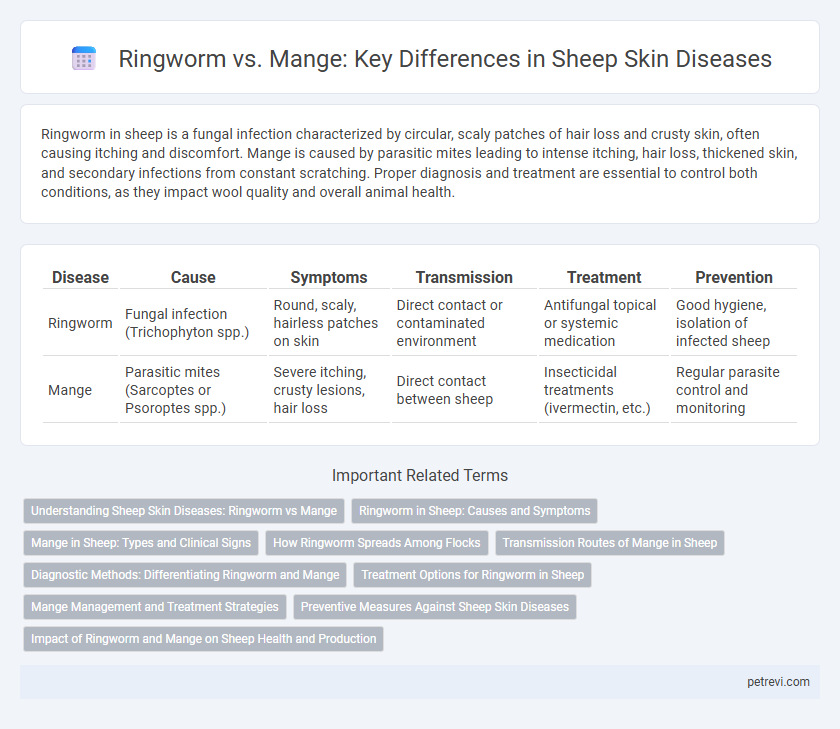Ringworm in sheep is a fungal infection characterized by circular, scaly patches of hair loss and crusty skin, often causing itching and discomfort. Mange is caused by parasitic mites leading to intense itching, hair loss, thickened skin, and secondary infections from constant scratching. Proper diagnosis and treatment are essential to control both conditions, as they impact wool quality and overall animal health.
Table of Comparison
| Disease | Cause | Symptoms | Transmission | Treatment | Prevention |
|---|---|---|---|---|---|
| Ringworm | Fungal infection (Trichophyton spp.) | Round, scaly, hairless patches on skin | Direct contact or contaminated environment | Antifungal topical or systemic medication | Good hygiene, isolation of infected sheep |
| Mange | Parasitic mites (Sarcoptes or Psoroptes spp.) | Severe itching, crusty lesions, hair loss | Direct contact between sheep | Insecticidal treatments (ivermectin, etc.) | Regular parasite control and monitoring |
Understanding Sheep Skin Diseases: Ringworm vs Mange
Ringworm in sheep manifests as circular, scaly lesions caused by fungal infections that are highly contagious and require antifungal treatment for control. Mange, caused by parasitic mites, leads to intense itching, hair loss, and inflamed skin, necessitating acaricidal treatments to eliminate the mites. Both conditions affect overall flock health and productivity, making accurate diagnosis and prompt intervention essential for effective management.
Ringworm in Sheep: Causes and Symptoms
Ringworm in sheep is a contagious fungal infection caused by dermatophytes, primarily Trichophyton and Microsporum species, that affects the skin, wool, and sometimes the hooves. The infection presents as circular, crusty lesions with hair loss, scaling, and inflammation, often leading to discomfort and reduced wool quality. Diagnosis is confirmed through clinical signs and fungal culture or microscopy, requiring timely antifungal treatment and improved hygiene to control the spread within the flock.
Mange in Sheep: Types and Clinical Signs
Mange in sheep is caused by various mite species, including Sarcoptes scabiei and Psoroptes ovis, leading to intense itching, hair loss, and thickened skin. Clinical signs of mange include crust formation, scabs, wool matting, and restless behavior due to pruritus. Effective diagnosis and treatment are crucial to prevent secondary infections and maintain flock health and productivity.
How Ringworm Spreads Among Flocks
Ringworm spreads among sheep flocks primarily through direct contact with infected animals or contaminated equipment, such as grooming tools and feeding areas. The fungal spores can survive in the environment for months, increasing the risk of transmission within close quarters. Effective sanitation and isolation of affected sheep are critical to controlling outbreaks and minimizing skin lesions caused by ringworm.
Transmission Routes of Mange in Sheep
Mange in sheep primarily transmits through direct contact with infested animals, making close proximity a significant risk factor. Contaminated bedding, grooming tools, and fences also serve as indirect transmission routes, facilitating the spread of mites. Effective management requires isolating affected sheep and maintaining strict hygiene protocols to prevent mite proliferation.
Diagnostic Methods: Differentiating Ringworm and Mange
Diagnostic methods for differentiating ringworm and mange in sheep primarily involve microscopic examination and skin scraping techniques. Ringworm, caused by dermatophyte fungi, is identified by detecting fungal spores and hyphae in hair and skin samples using a Wood's lamp or fungal culture. Mange, caused by parasitic mites, is diagnosed by microscopic identification of mites or their eggs from skin scrapings, allowing for targeted treatment.
Treatment Options for Ringworm in Sheep
Effective treatment options for ringworm in sheep include topical antifungal medications such as miconazole or clotrimazole applied directly to the affected skin areas. In more severe cases, systemic antifungal drugs like griseofulvin may be prescribed under veterinary supervision to eliminate the fungal infection. Proper hygiene measures, including isolating infected animals and disinfecting equipment, help prevent the spread of ringworm within the flock.
Mange Management and Treatment Strategies
Mange in sheep, caused primarily by mites such as Psoroptes ovis and Sarcoptes scabiei, requires prompt identification and targeted treatment to prevent severe skin damage and productivity loss. Effective mange management includes regular flock inspections, strategic use of acaricides like ivermectin or doramectin, and environmental hygiene to break the mite infestation cycle. Pasture rotation and isolation of affected animals further reduce transmission risk, ensuring healthier skin and improved overall flock health.
Preventive Measures Against Sheep Skin Diseases
Maintaining clean and dry living environments significantly reduces the risk of ringworm and mange in sheep by minimizing fungal spores and mite infestations. Regular inspection and early isolation of affected animals prevent the spread of contagious skin conditions within the flock. Implementing proper nutrition and stress management enhances the sheep's immune system, providing natural resistance against skin diseases like ringworm and mange.
Impact of Ringworm and Mange on Sheep Health and Production
Ringworm in sheep causes circular, scaly lesions leading to wool loss and skin damage, negatively affecting fleece quality and market value. Mange results from mites burrowing into the skin, causing intense itching, inflammation, and secondary infections, which reduce weight gain and overall productivity. Both conditions compromise animal welfare and require prompt treatment to minimize economic losses in sheep farming.
Ringworm vs Mange for Sheep Skin Diseases Infographic

 petrevi.com
petrevi.com